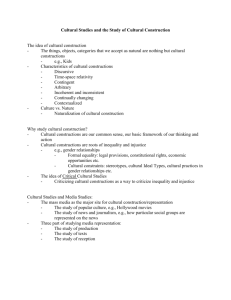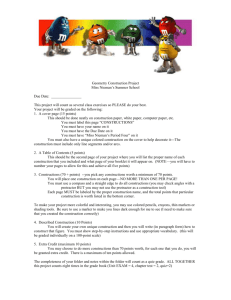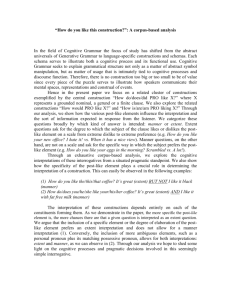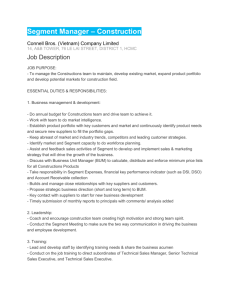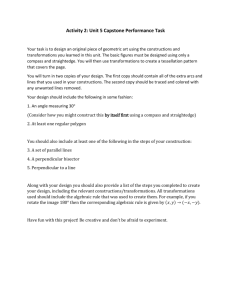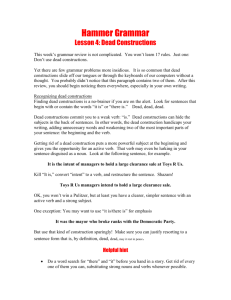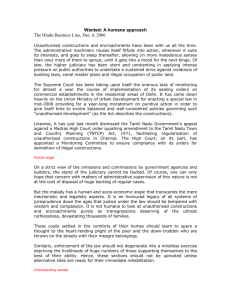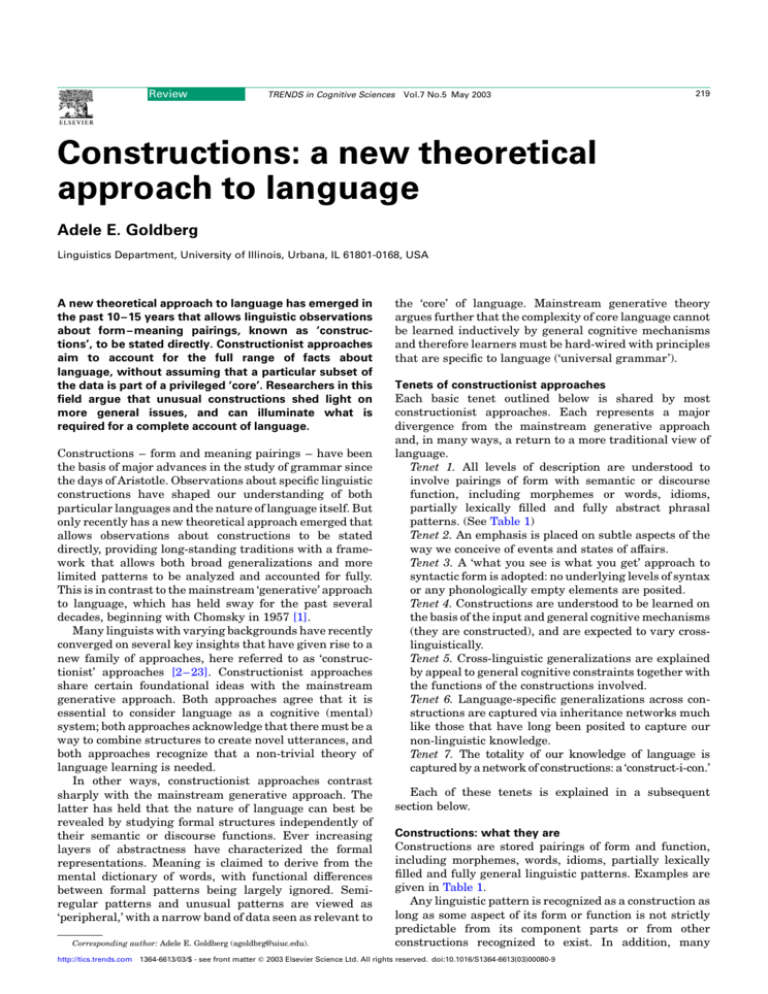
Review
TRENDS in Cognitive Sciences
Vol.7 No.5 May 2003
219
Constructions: a new theoretical
approach to language
Adele E. Goldberg
Linguistics Department, University of Illinois, Urbana, IL 61801-0168, USA
A new theoretical approach to language has emerged in
the past 10 –15 years that allows linguistic observations
about form –meaning pairings, known as ‘constructions’, to be stated directly. Constructionist approaches
aim to account for the full range of facts about
language, without assuming that a particular subset of
the data is part of a privileged ‘core’. Researchers in this
field argue that unusual constructions shed light on
more general issues, and can illuminate what is
required for a complete account of language.
Constructions – form and meaning pairings – have been
the basis of major advances in the study of grammar since
the days of Aristotle. Observations about specific linguistic
constructions have shaped our understanding of both
particular languages and the nature of language itself. But
only recently has a new theoretical approach emerged that
allows observations about constructions to be stated
directly, providing long-standing traditions with a framework that allows both broad generalizations and more
limited patterns to be analyzed and accounted for fully.
This is in contrast to the mainstream ‘generative’ approach
to language, which has held sway for the past several
decades, beginning with Chomsky in 1957 [1].
Many linguists with varying backgrounds have recently
converged on several key insights that have given rise to a
new family of approaches, here referred to as ‘constructionist’ approaches [2– 23]. Constructionist approaches
share certain foundational ideas with the mainstream
generative approach. Both approaches agree that it is
essential to consider language as a cognitive (mental)
system; both approaches acknowledge that there must be a
way to combine structures to create novel utterances, and
both approaches recognize that a non-trivial theory of
language learning is needed.
In other ways, constructionist approaches contrast
sharply with the mainstream generative approach. The
latter has held that the nature of language can best be
revealed by studying formal structures independently of
their semantic or discourse functions. Ever increasing
layers of abstractness have characterized the formal
representations. Meaning is claimed to derive from the
mental dictionary of words, with functional differences
between formal patterns being largely ignored. Semiregular patterns and unusual patterns are viewed as
‘peripheral,’ with a narrow band of data seen as relevant to
Corresponding author: Adele E. Goldberg (agoldbrg@uiuc.edu).
the ‘core’ of language. Mainstream generative theory
argues further that the complexity of core language cannot
be learned inductively by general cognitive mechanisms
and therefore learners must be hard-wired with principles
that are specific to language (‘universal grammar’).
Tenets of constructionist approaches
Each basic tenet outlined below is shared by most
constructionist approaches. Each represents a major
divergence from the mainstream generative approach
and, in many ways, a return to a more traditional view of
language.
Tenet 1. All levels of description are understood to
involve pairings of form with semantic or discourse
function, including morphemes or words, idioms,
partially lexically filled and fully abstract phrasal
patterns. (See Table 1)
Tenet 2. An emphasis is placed on subtle aspects of the
way we conceive of events and states of affairs.
Tenet 3. A ‘what you see is what you get’ approach to
syntactic form is adopted: no underlying levels of syntax
or any phonologically empty elements are posited.
Tenet 4. Constructions are understood to be learned on
the basis of the input and general cognitive mechanisms
(they are constructed), and are expected to vary crosslinguistically.
Tenet 5. Cross-linguistic generalizations are explained
by appeal to general cognitive constraints together with
the functions of the constructions involved.
Tenet 6. Language-specific generalizations across constructions are captured via inheritance networks much
like those that have long been posited to capture our
non-linguistic knowledge.
Tenet 7. The totality of our knowledge of language is
captured by a network of constructions: a ‘construct-i-con.’
Each of these tenets is explained in a subsequent
section below.
Constructions: what they are
Constructions are stored pairings of form and function,
including morphemes, words, idioms, partially lexically
filled and fully general linguistic patterns. Examples are
given in Table 1.
Any linguistic pattern is recognized as a construction as
long as some aspect of its form or function is not strictly
predictable from its component parts or from other
constructions recognized to exist. In addition, many
http://tics.trends.com 1364-6613/03/$ - see front matter q 2003 Elsevier Science Ltd. All rights reserved. doi:10.1016/S1364-6613(03)00080-9
220
Review
TRENDS in Cognitive Sciences
Vol.7 No.5 May 2003
Table 1. Examples of constructions, varying in size and complexity; form and function are specified if not readily transparent
Construction
Form/Example
Morpheme
Word
Complex word
Idiom (filled)
Idiom (partially filled)
Covariational-Conditional
construction [10]
e.g. anti-, pre-, -ing
e.g. Avocado, anaconda, and
e.g. Daredevil, shoo-in
e.g. Going great guns
e.g. Jog ksomeone’sl memory
Form: The Xer the
Yer (e.g. The more you think about it,
the less you understand)
Form: Subj [V Obj1
Obj2] (e.g. He gave her a Coke; He baked her a muffin)
Ditransitive
(double-object)
construction
Passive
Form: Subj aux VPpp (PPby) (e.g. The armadillo was hit
by a car)
constructionist approaches argue that patterns are stored
even if they are fully predictable as long as they occur with
sufficient frequency [24– 29].
Unlike mainstream generative grammar, the constructionist framework emphasizes the semantics and distribution of particular words, grammatical morphemes, and
cross-linguistically unusual phrasal patterns. The hypothesis behind this methodology is that an account of the rich
semantic, pragmatic, and complex formal constraints on
these patterns readily extends to more general, simple or
regular patterns.
As an example of an unusual pattern, consider the
Covariational Conditional construction in Table 1 (e.g. ‘The
more you think about it, the less you understand’). The
construction is interpreted as involving an independent
variable (identified by the first phrase) and a dependent
variable (identified by the second phrase). The word the
normally occurs at the beginning of a phrase headed by a
noun. But in this construction it requires a comparative
phrase. The two major phrases of the construction resist
classification as either noun phrases or clauses. The
requirement that two phrases of this type be juxtaposed
without conjunction is another non-predictable aspect of
the pattern. Because the pattern is not strictly predictable,
a construction is posited that specifies the particular form
and semantic function involved [10].
Other unusual constructions include those in Table 2.
Although some of the patterns are primarily used
colloquially, they are part of every native speaker’s
repertoire of English. (The stranded preposition construction is unusual not by virtue of its being prescriptively
dispreferred, but in that it is found only in a few Germanic
languages).
More common patterns such as passive, topicalization
Table 2. Productive or semi-productive constructions that are
unusual across languages and must be learned on the basis of
the input
time away construction
What’s X doing Y?
Twistin the night away [13]
What’s that fly doing
in my soup? [30]
Nominal Extraposition construction It’s amazing the difference! [31]
Mad Magazine construction
Him, a doctor?! [32]
Noun –Pronoun –Noun (N P N)
house by house; day
construction
after day [12]
Stranded preposition construction
Who did he give
that to?
http://tics.trends.com
Function
Meaning: linked independent and dependent variables
Meaning: transfer (intended or actual)
Discourse function: to make undergoer topical and/or
actor non-topical
and relative clauses are understood to be learned pairings
of form and (semantic or discourse) function – that is, they
are also constructions. Each pairs certain formal properties with a certain communicative function.
Even basic sentence patterns of a language can be
understood to involve constructions. That is, the main verb
can be understood to combine with an argument-structure
construction (e.g. transitive, intransitive, ditransitive
constructions, etc.) [7]. The alternative is to assume that
the form and general interpretation of basic sentence
patterns are determined by semantic and/or syntactic
information specified by the main verb. The sentence
patterns given in (1) and (2) indeed appear to be
determined by the specifications of give and put respectively:
(1) Chris gave Pat a ball.
(2) Pat put the ball on the table.
Give is a three-argument verb: an act of giving requires
three characters: a giver (or agent), a recipient, and
something given (or ‘theme’). It is therefore expected to
appear with three phrases corresponding to these three
roles. In (1), for instances, Chris is agent, Pat is recipient,
and a ball is theme. Put, another three-argument verb,
requires an agent, a theme (object that undergoes the
change of location) and a final location of the theme’s
motion. It appears with the corresponding three arguments in (2). However, whereas (1) and (2) represent
perhaps the prototypical case, in general the interpretation and form of sentence patterns of a language are not
reliably determined by independent specifications of the
main verb. For example, it is implausible to claim that
sneeze has a three-argument sense, and yet it can appear
as such in (3). The patterns in (4)– (6) are likewise not
naturally attributed to the main verbs:
(3) ‘He sneezed his tooth right across town.’ (Robert
Munsch, Andrew’s Loose Tooth)
(4) ‘She smiled herself an upgrade.’ (Douglas Adams,
Hitchhiker’s Guide to the Galaxy, Harmony Books)
(5) ‘We laughed our conversation to an end.’ (J. Hart. Sin
Ivy Books, New York)
(6) ‘They could easily co-pay a family to death.’ (New York
Times, 1/14/02)
Examples need not be particularly novel to make the
point. Verbs typically appear with a wide array of
Review
TRENDS in Cognitive Sciences
complement configurations. Consider the verb slice and
the various constructions in which it can appear (labeled in
parentheses):
(7)
a. He sliced the bread. (transitive)
b. Pat sliced the carrots into the salad. (caused
motion)
c. Pat sliced Chris a piece of pie. (ditransitive)
d. Emeril sliced and diced his way to stardom. (way
construction)
e. Pat sliced the box open. (resultative)
In all of these expressions slice means to cut with a
sharp instrument. It is the argument-structure constructions that provide the direct link between surface form and
general aspects of the interpretation, such as something
acting on something else (7a), something causing something else to move(7b), someone intending to cause
someone to receive something (7c), someone moving
somewhere(7d), someone causing something to change
state(7e) [7,33].
Thus constructions can be seen to be essential to an
effective account of both unusual or especially complex
patterns, and of the basic, regular patterns of language.
The functions of constructions
Different surface forms are typically associated with
slightly different semantic or discourse functions. Take
for example, the ‘ditransitive’ construction, which involves
the form, Subject– Verb – Object1– Object2, as in (1), (8b)
and (9b).
(8)
a. Liza bought a book for Zach.
b
Liza bought Zach a book.
(9)
a. Liza sent a book to storage.
b. Liza sent Stan a book.
c. ??Liza sent storage a book.
The ditransitive form evokes the notion of transfer or
‘giving’. This is in contrast to possible paraphrases. For
example, whereas (8a) can be used to mean that Liza
bought a book for a third party because Zach was too busy
to buy it himself, (8b) can only mean that Liza intended to
give Zach the book. Similarly whereas (9a) can be used to
entail caused motion to a location (the book is caused to go
to storage), the ditransitive pattern requires that the goal
argument be an animate being, capable of receiving the
transferred item (cf. 9b, 9c). As is clear from considering
the paraphrases, the implication of transfer is not an
independent fact about the words involved. Rather the
implication of transfer comes from the ditransitive construction itself.
Other interpretations for the ditransitive can also be
systematically related to the notion of transfer, in that they
imply that the transfer will occur if certain satisfaction
conditions evoked by the main verb occur (10a), that
transfer will not occur (10b), or that the antonymic relation
of giving occurs – that of taking away (10c). Even
examples such as ‘Cry me a river’ can be related to the
notion of giving via a metaphorical extension [7].
http://tics.trends.com
221
Vol.7 No.5 May 2003
(10)
a.
b.
c.
Liza guaranteed Zach a book. (If the guarantee is
satisfied, Z. will receive a book)
Liza refused Zach a book. (Liza caused Zach not
to receive a book)
Liza cost Zach his job. (Liza causes Zach to lose
his job).
In addition to semantic generalizations there also exist
generalizations about ‘information structure’ properties of
the construction, or the way in which a speaker’s
assumptions about the hearer’s state of knowledge and
consciousness at the time of speaking is reflected in surface
form. In particular, there is a statistically reliable
tendency for the recipient argument to have already
been mentioned in the discourse (often encoded by a
pronoun) as compared with prepositional paraphrases
[9,34,35]. Facts about the use of entire constructions,
including register (e.g. formal or informal), dialect
variation and so on, are stated as part of the construction
as well. Because they specify a surface form and a
corresponding function, constructionist approaches provide a direct way of accounting for these facts.
The form of constructions
To capture differences in meaning or discourse properties
between surface forms, constructionist theories do not
derive one construction from another, as is commonly done
in mainstream generative theory. An actual expression or
‘construct’ typically involves the combination of at least
half a dozen different constructions. For example, the
construct in Fig. 1a involves the list of constructions given
in Fig. 1b.
Note that ‘surface form’ need not specify a particular
word order, nor even particular grammatical categories,
although there are constructions that do specify these
features. For example, the ditransitive construction (in
Fig. 1 and discussed in the previous section) is characterized in terms of a set of argument types. The overt order of
arguments in the ditransitive construction in Fig. 1 is
determined by a combination of a Verb-Phrase (VP)
construction with the Question construction, the latter
allowing the ‘theme’ argument (represented by What) to
appear in the sentence-initial position.
Constructions can be combined freely to form actual
expressions as long as they are not in conflict. For example,
the specification of the ditransitive construction that
(a) [ What did Liza buy the child? ]
(b) 1.
2.
3.
4.
5.
6.
Liza, buy, the, child, what, did constructions (i.e. words)
Ditransitive construction
Question construction
Subject–Auxiliary inversion construction
VP construction
NP construction
TRENDS in Cognitive Sciences
Fig. 1. (a) An expression, or ‘construct’, that is a combination of the constructions
shown in (b), color-coded to the appropriate parts of the expression (VP, VerbPhrase; NP, Noun-Phrase). See text for discussion.
222
Review
TRENDS in Cognitive Sciences
requires an animate recipient argument conflicts with the
meaning of storage in (9c) resulting in unacceptability. The
observation that language has an infinitely creative
potential [1,36] is accounted for, then, by the free
combination of constructions.
Learning constructions
The fourth tenet states that constructions are understood
to be learned on the basis of positive input and to vary
across languages. This idea highlights a major difference
between most constructional approaches and most mainstream generative approaches, as the latter have argued
that learners must be hard-wired with principles specific
to a language faculty, that is, to possess a ‘universal
grammar’ ([37]; see also [21]).
Crucially, all linguists recognize that a wide range of
semi-idiosyncratic constructions exist in every language,
constructions that cannot be accounted for by general,
universal or innate principles or constraints (see examples
in Table 2). Mainstream generative theory has taken the
position that these constructions exist only on the
‘periphery’ of language, and that therefore they need not
be the focus of linguistic or learning theorists [37].
Constructionist approaches, on the other hand, have
zeroed in on these constructions, arguing that whatever
means we use to learn these patterns can easily be
extended to account for so-called ‘core’ phenomena. In fact,
by definition, the core phenomena are more regular, and
also tend to occur more frequently within a given
language. Therefore if anything, they are likely to be
easier to learn. Because every linguist would presumably
agree that the ‘peripheral’, difficult cases must be learned
inductively on the basis of the input, constructionist
theories propose that there is no reason to assume that
the more general, regular, frequent cases cannot possibly
be learned in this way.
In fact, constructionist theories argue that language
must be learnable from positive input together with fairly
general cognitive abilities [18,29,38], because the diversity
and complexity witnessed does not yield to accounts that
assume that cross-linguistic variation can be characterized in terms of a finite set of parameters [37]. Research in
this area is quickly gaining momentum. Several constructionists have made good on the promise to explain how
particular constructions are learned [26,27]. It turns out
that the input need not be nearly as impoverished as is
sometimes assumed [39]; analogical processes can be seen
to be viable once function as well as form is taken into
account [40,41]; there is good reason to think that
children’s early grammar is quite conservative, with
generalizations emerging only slowly [29,42,43]; and the
ability to record transitional probabilities and statistical
generalizations in the input has proven a powerful means
by which to learn certain types of generalizations [44].
This approach takes a somewhat different view from
mainstream generative theory of what is universal about
language. Linguists talk of certain constructions as
existing in many languages, for example, the passive
construction, relative clause construction, question construction, and so forth. However, two constructions in
different languages can be identified as instances of the
http://tics.trends.com
Vol.7 No.5 May 2003
same construction if and only if their form and function is
identical once other constructions in the language that
might differ are factored out. In fact, this rarely occurs
except in cases of shared diachronic history or language
contact [20,45,46]. What is truly remarkable is the degree
to which human languages differ from one another, given
that all languages need to express roughly the same types
of messages. Constructionist approaches anticipate such
fairly wide variability across languages [47,48].
We can understand what is actually intended by
references to the ‘same’ construction in unrelated
languages as types of constructions. Two constructions
might be, for example, of the passive type in that they
share certain functional and formal characteristics even if
they are not identical. That is, two constructions in
different languages can be identified as instances of the
same type of construction if and only if they serve a closely
related function and form.
Cross-linguistic generalizations
A driving question behind much of linguistic research is
what is the typology of possible constructions and what
constrains it? Constructionist approaches often turn to
grammar-external explanations such as universal functional pressures, iconic principles, and processing and
learning constraints to explain such empirically observable cross-linguistic generalizations. For example, certain
generalizations about how form and meaning tend to be
linked across languages can be explained by appeal to
iconic and analogical processes [6,35,49 – 51]. Constraints
on long-distance dependency constructions (traditional
‘island constraints’) appear to yield to processing explanations that take into account the function of the
constructions involved [19,52– 54]. Processing accounts
have also been suggested to account for certain alternative
word-order options [55,56].
Even among generative linguists there has been a trend
towards the view that many constraints on language that
have traditionally been seen as requiring recourse to
innate stipulations specific to language can actually be
explained by general cognitive mechanisms. For example,
the fact that that all languages appear to have noun and
verb (and, possibly, adjective) categories may be explained
by the existence of corresponding basic semantic categories [57]. In a recent paper, Hauser, Chomsky and Fitch
go so far as to suggest that the only language-specific
innate ability that is absolutely required is recursion, and
they raise the point that even that might turn out not to be
specific to language [58] (see also Box 1. Questions for
Future Research).
Intra-language generalizations
Inheritance hierarchies have long been found useful for
representing all types of knowledge, for example, our
knowledge of concepts. The construction-based framework
captures linguistic generalizations within a particular
language via the same type of inheritance hierarchies
[2,59,60]. Broad generalizations are captured by constructions that are inherited by many other constructions;
more limited patterns are captured by positing constructions at various midpoints of the hierarchical network.
Review
TRENDS in Cognitive Sciences
Box 1. Questions for Future Research
† Do there exist generalizations about form that do not have
even an abstract, family-resemblance or radial category
type generalization about function associated with them?
† Does learning one construction facilitate learning other
related constructions?
† What is the relationship between type and token frequencies in acquisition?
† If principles that are specific to language are not hardwired into our brains, how exactly do we differ from other
primates who do not develop human-like languages?
† How great a role do general processing principles play in
determining possible languages?
Exceptional patterns are captured by low-level constructions. For example, the ‘What’s X doing Y?’ construction,
which has a fixed form and connotes some sort of
unexpectedness, captures a pattern in English grammar.
It inherits properties from several other more general
constructions, including the Left Isolation, the Subject –
Auxiliary Inversion, the Subject – Predicate and the VerbPhrase constructions [30].
Constructions all the way down
What makes a theory that allows for constructions a
‘construction-based’ theory is Tenet 7: the idea that the
network of constructions captures our knowledge of
language in toto – in other words, it’s constructions all
the way down.
Conclusion
Constructionist theories set out to account for all of our
knowledge of language as patterns of form and function.
That is, the constructionist approach does not assume that
language should be divided up into ‘core’ grammar and
the to-be-ignored ‘periphery.’ In identifying constructions,
an emphasis is placed on subtle aspects of construal and
on surface form. Cross-linguistic generalizations are
explained by appeal to general cognitive constraints
together with the functions of the constructions involved.
Language-specific generalizations across constructions
are captured via inheritance networks. The inventory of
constructions, which includes morphemes or words,
idioms, partially lexically filled and fully abstract phrasal
patterns, is understood to be learned on the basis of the
input together with general cognitive mechanisms.
Acknowledgements
I am grateful to Ray Jackendoff, Fritz Newmeyer, Devin Casenhiser, Mike
Tomasello, Ali Yazdani and the anonymous referees for advice on an
earlier draft. I am sure I will regret any I failed to heed.
References
1 Chomsky, N. (1957) Syntactic Structures, Mouton
2 Lakoff, G. (1987) Women, Fire and Dangerous Things: What Categories
Reveal About the Mind, University of Chicago Press
3 Langacker, R.W. (1987/1991) Foundations of Cognitive Grammar
(Vols I & II), Stanford University Press
4 Fillmore, C.J. et al. (1988) Regularity and idiomaticity in grammatical
constructions: the case of let alone. Language 64, 501– 538
http://tics.trends.com
Vol.7 No.5 May 2003
223
5 Wierzbicka, A. (1988) The Semantics of Grammar, John Benjamins
Publishing
6 Lambrecht, K. (1994) Information Structure and Sentence Form,
Cambridge University Press
7 Goldberg, A.E. (1995) Constructions: A Construction Grammar
Approach to Argument Structure, Chicago University Press
8 Gleitman, L. et al. (1996) ‘Similar’ and similar concepts. Cognition 58,
321 – 376
9 Thompson, S.A. (1990) Information flow and dative shift in english
discourse. In Development and Diversity: Linguistic Variation Across
Time and Space (Edmondson, J., ed.), pp. 239 – 253, Summer Institute
of Linguistics, Dallas
10 Culicover, P.W. and Jackendoff, R. (1999) The view from the periphery:
the English comparative correlative. Linguist. Inq. 30, 543 – 571
11 Zwicky, A. (1994) Dealing out meaning: fundamentals of syntactic
constructions. Berkeley Linguist. Soc. 20, 611 – 625
12 Williams, E. (1994) Remarks on lexical knowledge. Lingua 92, 7 – 34
13 Jackendoff, R. (1997) Twistin’ the night away. Language 73, 534 – 559
14 Sag, I.A. (1997) English relative clause constructions. J. Linguist. 33,
431– 484
15 Webelhuth, G. and Ackerman, F. (1998) A Theory of Predicates, CSLI
Publications/Cambridge University Press
16 Iwata, S. (1998) A Lexical Network Approach to Verbal Semantics,
Kaitakusha, Tokyo
17 Shibatani, M. (1999) Dative subject constructions 22 years later. Stud.
Linguist. Sci. 29, 45 – 76
18 Culicover, P.W. (1999) Syntactic Nuts: Hard Cases in Syntax, Oxford
University Press
19 van Valin, R. Jr (1998) The acquisition of WH-questions and the
mechanisms of language acquisition. In The New Psychology of
Language: Cognitive and Functional Approaches to Language Structure (Tomasello, M., ed.), pp. 221 – 249, Erlbaum
20 Croft, W. (2001) Radical Construction Grammar, Oxford University
Press
21 Jackendoff, R. (2002) Foundations of Language, Oxford University
Press
22 Bybee, J. (2001) Main clauses are innovative, subordinate clauses are
conservative: consequences for the nature of constructions. In Complex
Sentences in Grammar and Discourse: Essays in Honor of Sandra
A. Thompson (Bybee, J. and Noonan, M., eds) pp. 1 – 17, John
Benjamins
23 Booij, G. (2002) Constructional idioms, morphology, and the dutch
lexicon. J. Germanic Linguist. 144, 301– 329
24 Langacker, R.W. (1988) A usage-based model. In Topics in Cognitive
Linguistics (Rudzka-Ostyn, B., ed.), pp. 127– 161, John Benjamins
25 Barlow, M. and Kemmer, S. (2000) Usage Based Models of Grammar,
CSLI Publications/Cambridge University Press
26 Israel, M. et al. (2000) From states to events: the acquisition of english
passive participles. Cogn. Linguist. 11, 1 – 27
27 Diessel, H. and Tomasello, M. (2001) The acquisition of finite
complement clauses in English: a usage based approach to the
development of grammatical constructions. Cogn. Linguist. 12,
97 – 141
28 Verhagen, A. (2002) From parts to wholes and back again. Cogn.
Linguist. 1, 13 – 14
29 Tomasello, M. Constructing a Language: A Usage-Based Theory of
Language Acquisition. Harvard University Press (in press)
30 Kay, P. and Fillmore, C.J. (1999) Grammatical constructions and
linguistic generalizations: the What’s X doing Y? construction.
Language 75, 1 – 34
31 Michaelis, L.A. and Lambrecht, K. (1996) Toward a construction-based
model of language function: the case of nominal extraposition.
Language 72, 215 – 247
32 Lambrecht, K. (1990) ‘What, me worry?’ Mad Magazine sentences
revisited. Proc. 16th Annu. Meet. Berkeley Linguist. Soc., pp. 215 – 228,
University of California
33 Goldberg, A.E. Argument realization: the role of constructions, lexical
semantics and discourse factors. In Construction Grammar(s):
Cognitive and Cross-Language Dimensions (Fried, M. and Östman,
J.O., eds.), John Benjamins (in press)
34 Erteschik-Shir, N. (1979) Discourse constraints on dative movement.
In Syntax and Semantics (Laberge, S. and Sankoff, G., eds)
pp. 441– 467, Academic Press
224
Review
TRENDS in Cognitive Sciences
35 Wasow, T. (2002) Postverbal Behavior, CSLI Publications
36 Chomsky, N. (1965) Aspects of the Theory of Syntax, MIT Press
37 Chomsky, N. (1981) Lectures on Government and Binding, Foris,
Dordrecht
38 Elman, J. et al. (1996) Rethinking Innateness: A Connectionist
Perspective on Development, MIT Press
39 Pullum, G.K. and Scholz, B.C. (2002) Empirical assessment of
stimulus poverty arguments. Linguist. Rev. 19, 9 – 50
40 Goldberg, A.E. (1999) The Emergence of argument structure semantics. In The Emergence of Language (MacWhinney, B., ed.),
pp. 197– 212, Erlbaum
41 Israel, M. (2002) Consistency and creativity in first language
acquisition. Proc. Berkeley Linguist. Soc., p. 29
42 Lieven, E.V.M. et al. (1997) Lexically-based learning and early
grammatical development. J. Child Lang. 24, 187 – 219
43 Tomasello, M. (2000) Do young children have adult syntactic
competence? Cognition 74, 209 – 253
44 Saffran, J.R. (2001) The use of predictive dependencies in language
learning. J. Mem. Lang. 44, 493 – 515
45 Birner, B. and Ward, G. (1998) Information Status and Noncanonical
Word Order in English, John Benjamins
46 Zhang, N. (1998) The interactions between construction meaning and
lexical meaning. Linguistics 36, 957 – 980
47 Foley, W.A. and van Valin, R. Jr (1984) Functional Syntax and
Universal Grammar, Cambridge University Press
48 Garry, J. and Rubino, C., eds. (2001) Facts about the World’s
Languages: An Encyclopedia of the World’s Major Languages Past
and Present. H.W. Wilson
Vol.7 No.5 May 2003
49 Haiman, J. (1985) Iconicity in Syntax, Cambridge University Press
50 Givón, T. (1991) Isomorphism in the grammatical code: cognitive and
biological considerations. Studies Lang. 1, 85– 114
51 Kemmer, S. and Verhagen, A. (2002) The grammar of causatives and
the conceptual structure of events. Mouton Classics: From Syntax to
Cognition, From Phonology to Text, pp. 451 – 491, Mouton de Gruyter
52 Kluender, R. (1998) On the distinction between strong and weak
islands: a processing perspective. Syntax Semantics 29, 241– 279
53 Kluender, R. and Kutas, M. (1993) Subjacency as a processing
phenomenon. Lang. Cogn. Process. 8, 573 – 633
54 Erteschik-Shir, N. (1998) The syntax-focus structure interface. In
Syntax and Semantics Vol. 29: The Limits of Syntax (Culicover, P. and
McNally, L., eds.), pp. 211 – 240, Academic Press
55 Hawkins, J. (1994) A Performance Theory of Order and Constituency,
Cambridge University Press
56 Yamashita, H. and Chang, F. (2001) ‘Long before short’ preference in
the production of a head-final language. Cognition 81, B45– B55
57 Baker, M. (2003) Verbs, Nouns, and Adjectives: Their Universal
Grammar. Cambridge University Press (in press)
58 Hauser, M.D. et al. (2002) The faculty of language: what is it, who has
it, and how did it evolve? Science 298, 1569 – 1579
59 Pollard, C.J. and Sag, I. (1994) Head-Driven Phrase Structure
Grammar, CSLI Publications/Cambridge University Press
60 Goldberg, A.E. Words by default: inheritance and the Persian Complex
Predicate Construction. In Mismatch: Form –Function Incongruity
and the Architecture of Grammar (Francis, E. and Michaelis, L., eds.),
CSLI Publications (in press)
News & Features on BioMedNet
Start your day with BioMedNet’s own daily science news, features, Research Update articles and special reports. Every two weeks,
enjoy BioMedNet Magazine, which contains free articles from Trends, Current Opinion, Cell and Current Biology. Plus, subscribe to
Conference Reporter to get daily reports direct from major life science meetings.
http://news.bmn.com
Here is what you will find in News & Features:
Today’s News
Daily news and features for life scientists.
Sign up to receive weekly email alerts at http://news.bmn.com/alerts
Special Report
Special in-depth report on events of current importance in the world of the life sciences.
Research Update
Brief commentary on the latest hot papers from across the life sciences, written by laboratory researchers chosen by the editors of
the Trends and Current Opinions journals, and a panel of key experts in their fields.
Sign up to receive Research Update email alerts on your chosen subject at http://update.bmn.com/alerts
BioMedNet Magazine
BioMedNet Magazine offers free articles from Trends, Current Opinion, Cell and BioMedNet News, with a focus on issues of general
scientific interest. From the latest book reviews to the most current Special Report, BioMedNet Magazine features Opinions, Forum
pieces, Conference Reporter, Historical Perspectives, Science and Society pieces and much more in an easily accessible format. It
also provides exciting reviews, news and features, and primary research. BioMedNet Magazine is published every 2 weeks.
Sign up to receive weekly email alerts at http://news.bmn.com/alerts
Conference Reporter
BioMedNet’s expert science journalists cover dozens of sessions at major conferences, providing a quick but comprehensive report
of what you might have missed. Far more informative than an ordinary conference overview, Conference Reporter’s easy-to-read
summaries are updated daily throughout the meeting.
Sign up to receive email alerts at http://news.bmn.com/alerts
http://tics.trends.com

